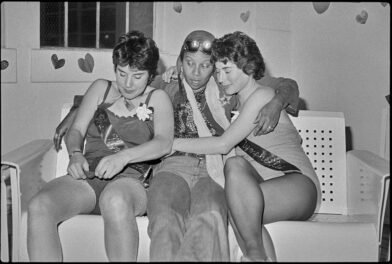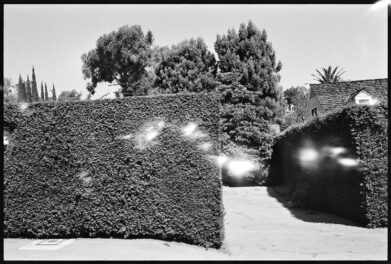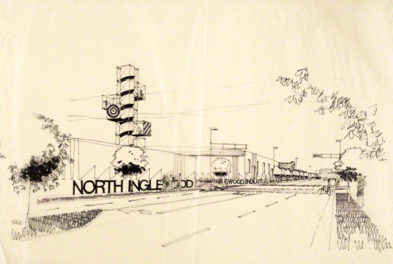Today the longtime LACMA curator Maurice Tuchman is best known for the museum’s pioneering Art and Technology initiative. Tuchman’s papers, which he recently donated to the Getty Research Institute, provide insight into that important project but also shed light on lesser-known elements of both his character and career.
From the Bronx to L.A.
Tuchman grew up far from Los Angeles, in a working and middle-class Jewish neighborhood in the Bronx. His parents had fled the rise of Nazi anti-Semitism to resettle first in Jacksonville, Florida—where Tuchman was born in 1936—and later in New York, where his father took up a job as a matzo baker. The young Maurice originally had dreamed of being a comic book artist, but instead found a new passion for art history while an undergraduate at City College of New York.

Drawing by Maurice Tuchman, 1950
Tuchman then enrolled in the graduate program at Columbia University to work with art historian Meyer Schapiro. His classmates there included future luminaries such as critic Barbara Rose—whose papers are also at the Research Institute—and artist Donald Judd. After a brief stint at the Guggenheim Museum, the 27-year-old Tuchman became LACMA’s founding curator of modern art in 1964.
Tuchman’s first exhibition was The New York School (1965), an early examination of the abstract expressionists from the 1950s to the 1960s. The following year Tuchman gave assemblage artist Edward Kienholz a one-man show. Among the various assemblages on view was Kienholz’s Back Seat Dodge ‘38 (1964), a sculptural tableau featuring two figures making out in the backseat of an actual automobile. The piece brought Tuchman one of his first brushes with controversy when it was deemed pornographic by Warren Dorn, then on the L.A. County Board of Supervisors. Dorn’s threat to withdraw funding from the museum ultimately backfired, attracting crowds to the exhibition.

Maurice Tuchman and Henry Hopkins during the installation of the exhibition American Sculpture of the Sixties, 1967, photographer unknown. Sculpture, background: Goddess of the Golden Thighs, 1964–65, Reuben Nakian. Bronze, 6′ x 12′. Sculpture, foreground: Untitled, 1962–63, David Smith. Stainless steel, 97″ x 63″ x 27 1/2″. Art © The Estate of David Smith/Licensed by VAGA, New York, NY
Art, Power, Scholarship, Money
The Art and Technology program at LACMA was Tuchman’s brainchild, and the project for which he is best known. With the goal of stimulating cross-disciplinary collaboration, from 1967 to 1971 Art and Technology paired forward-looking artists such as Claes Oldenburg, Andy Warhol, James Turrell, and Robert Irwin with partners in business and research, including General Electric, Disney, and the RAND Corporation. The ambitious initiative culminated in a 1971 exhibition at LACMA, and Tuchman was also invited to make a presentation at the 1970 World Expo in Osaka, Japan.
As with the Kienholz show, scandal surrounded the Art and Technology exhibition, as well as Tuchman’s later Art in Los Angeles: Seventeen Artists in the Sixties (1981), both of which were protested for their failure to include any women artists. But Tuchman later had a hand in restoring the Swedish painter Hilma af Klint to her rightful place as a pioneer of abstraction by including her work, made before World War I, in The Spiritual in Art: Abstract Painting 1890-1985 (1986).
Tuchman’s long career at LACMA encompassed many other important exhibitions, including American Sculpture of The Sixties (1967), The Avant-Garde in Russia, 1910-30: New Perspectives (1980), and Parallel Visions: Modern Artists and Outsider Art (1992). The correspondence, photographs, recordings, and appointment books that can be found in his papers document these projects, as do papers of friends and colleagues also held at the Research Institute, such as Barbara Rose, Lawrence Allloway, Henry Hopkins, and Betty Asher.
Indeed, as a whole these papers record Tuchman’s many contacts. His position as curator at LACMA put him at the center of the L.A. art world, and he regularly hosted parties for artists, collectors, celebrities, and socialites alike. Tuchman relished the cosmopolitan glamour of his career. As early as his time at the Guggenheim he stated: “A museum is a place where it all happens—a confluence of art and power, scholarship and money.”

Maurice Tuchman with Tony Curtis. Unknown photographer
A Legacy of Art and Tech
Today, the continued relevance of Tuchman’s legacy can be found in examples such as the nonprofit organization Machine Project, which supports artists working with science and technology, and LACMA’s own recent revival of the Art + Technology Lab, which like its predecessor connects artists with industrial giants to explore the intersection of art, creativity, technology, and industry.
Beyond these highlights, Tuchman’s papers also reveal lesser-known qualities of his character and his work: his pride in his Jewish heritage, for example. It was curiosity about his Jewish-European cultural roots that compelled him as a young man to spend a year after graduate school in Berlin. His Jewish identity remained with Tuchman throughout his life, surfacing for example in his friendship with the artist R. B. Kitaj, and also in his passion for the work and life of artist Chaim Soutine, for whom Tuchman co-authored the catalogue raisonné.
Once processed and catalogued, the Maurice Tuchman papers will be available for consultation by qualified researchers.

See all posts in this series »




I too grew up in a (partly) Jewish neighborhood in the Bronx in the 1930s and 1940s, and studied with Meyer Schapiro at Columbia University in the 1950s and 60s (what art historian of that era did not?). I remember being in classes there with Maurice Tuchman. My doctorate, however, was in eighteenth-century French sculpture. i have just retired as professor of Art History and director of the Art History program at Montclair State University, New Jersey.